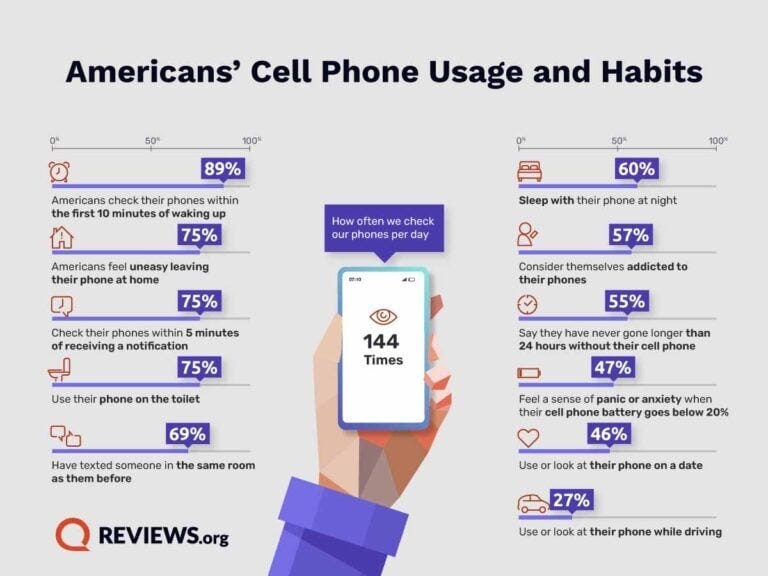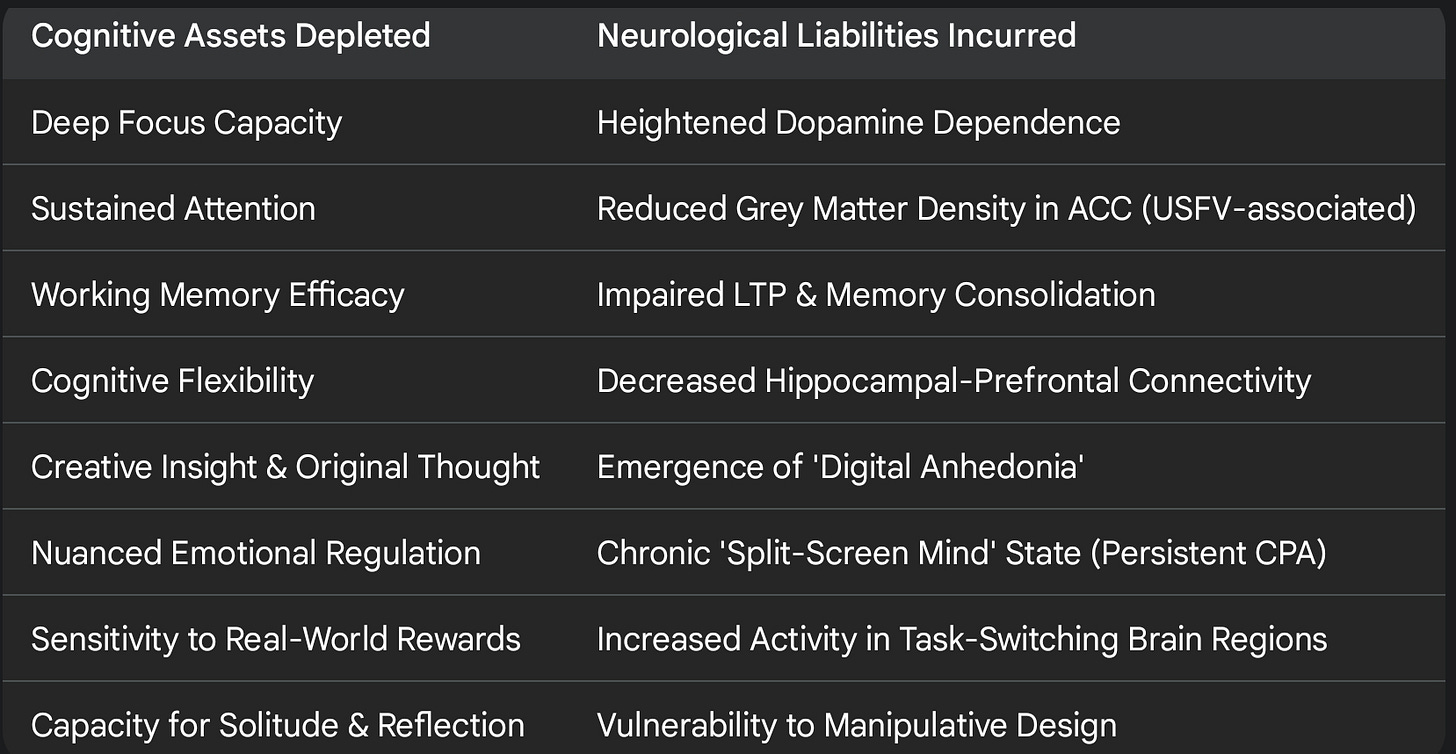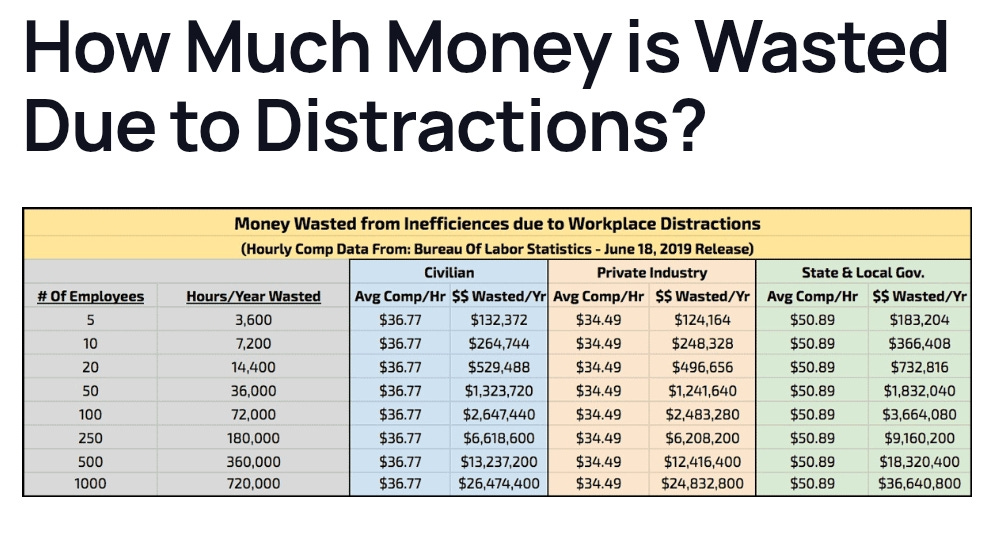The Sunday Big Think -The Neurological Price of Perpetual Partial Attention
How the Attention Economy is Reshaping Human Cognition
Happy Sunday Doom Scrollers,
Ever get that nagging feeling your brain's been leased out to the highest bidder, and you didn’t even see the contract? Or perhaps more pointedly, when was the last time you truly owned a full, uninterrupted hour of your own thoughts? If the answer involves a silent meditation retreat, you're not alone. Most of us are living in a state of cognitive sharecropping, our mental acreage tilled by forces we barely acknowledge. This isn't just about being "distracted." Something far more profound, more neurological, is afoot. We are paying a steep price for our always-on world, and the invoice is being tallied in the very architecture of our brains. The question is no longer if our cognition is changing, but how deeply, how permanently, and whether the entity staring back from the screen still holds the lease on its own mind.
Beyond Distraction: Welcome to the Age of Perpetual Partial Attention (PPA)
What most of us experience daily isn't multitasking, but Perpetual Partial Attention (PPA). Linda Stone, who coined "Continuous Partial Attention" (CPA) in 1998, describes it as constantly scanning in an effort to not miss anything. Unlike multitasking's conscious drive for productivity, CPA is an almost automatic, unconscious process, a primal fear of being out of the loop – "the desire to be a live node on the network".
Imagine your brain with too many browser tabs open – that's PPA. It's fueled by FOMO, anxiety about staying informed, and the lure of instant gratification. Our brains are wired for this; every notification is a siren song promising a dopamine hit. This isn't a conscious choice; it's a conditioned response. In our networked world, disconnection feels like obsolescence, pulling us towards PPA even as we recognize its harm. The paradox: striving to be a "live node" everywhere, we risk being truly present nowhere.
The Architects of Twitch: How the Attention Economy Rewired Our World (and Our Heads)
This cognitive fragmentation wasn't accidental; it was designed. Welcome to the "Attention Economy." Nobel laureate Herbert A. Simon, as far back as 1971, observed that "in an information-rich world, the wealth of information means a dearth of something else: a scarcity of whatever it is that information consumes... attention". Michael H. Goldhaber later argued attention would be the new economy's driving force.
And how that poverty of attention has been exploited. Human attention is scarce, finite, and valuable. Your eyeballs are the product, your clicks the currency, and digital platforms are the marketplaces. These platforms harvest and sell your attention to advertisers. As one cartoon quipped, "Somebody is getting rich from all the tech addiction—but it's not the consumer". They didn't aim to give us the attention span of a caffeinated squirrel; they just wanted to "connect the world"... and sell ads.
Simon's framework has been critiqued; some argue attention isn't a single resource but an emergent property of competition between stimuli for cognitive processing. If so, the "enemy" is the sophisticated design of systems engineered to capture our focus. The scarcity of attention is actively manufactured for profit, leveraging psychological vulnerabilities and dopamine-driven feedback loops. Tristan Harris called this "the race to the bottom of the brain stem". An economy built on attention inevitably reshapes the organ that produces it.
Your Brain on Infinite Scroll: The Neurological Downgrade
PPA and the attention economy are physically and functionally altering our brains via neuroplasticity – the brain's ability to reorganize based on experience. We've been feeding our brains digital glitter and fragmented information.
The dopamine system is key. Every "like" or notification releases dopamine, creating an addictive feedback loop, like a slot machine. This is mirrored by brain changes: increased activity in the anterior cingulate cortex (ACC) and dorsolateral prefrontal cortex (DLPFC) – regions for attention switching and cognitive control. Chronic exposure to ultra-short-form video (USFV) like TikToks is linked to decreased gray matter density in the ACC, potentially making individuals more impulsive.
Memory suffers. Hippocampus function may be impaired. Prolonged short-form content exposure weakens connectivity between the hippocampus and prefrontal cortex, hindering memory consolidation. Long-Term Potentiation (LTP), how memories "stick," is reduced by constant attentional switching. Our memories are becoming less sticky.
Working memory capacity is impaired ; cognitive flexibility weakens, reducing creative thinking. "Digital anhedonia" – a blunted reward response to real-world stimuli – can emerge. The real world can't compete with online dopamine fireworks.
The brain adapts to constant, shallow stimuli, making it less suited for deep focus or complex problem-solving. Some report a "split-screen mind," where attention feels involuntarily fragmented even offline, suggesting CPA as an ingrained state. Adolescents are particularly vulnerable, as reinforced circuits become deeply ingrained.
Table 1: The Brain's Balance Sheet in the Attention Economy
This balance sheet isn't looking good for Team Human.
So, We're Basically Goldfish Now? The Data Doesn't Lie (Much)
You've heard it: average human attention span plummeted from 12 seconds (2000) to 8 seconds (2013-2020), less than a goldfish's 9 seconds. While the "goldfish stat" (from a Microsoft Canada report) is critiqued for methodology , the trend is undeniable: our attention isn't just shorter; it's shattered.
The average person checks their phone 58 times daily; 75% can't focus long without distraction. Teenagers focus on a single task for 65 seconds; office workers 3 minutes. Multitasking is mostly rapid task-switching, costing cognitive resources, increasing errors, and hampering creativity. It’s like juggling flaming torches while unicycling on a tightrope over sharks – mostly, you become shark food. The "goldfish stat," robust or not, symbolizes our struggle. If constant distraction is normal, deep focus becomes rebellion.
The Price of the Ping: Fallout in Work, Wealth, and Wellbeing
The consequences ripple outwards. Economically, constant task-switching slashes productivity by up to 40%. The McKinsey Global Institute estimated in 2024 that attention fragmentation costs the global economy ~$1.3 trillion annually. That's Mars mission money.
PPA encourages shallow cognitive processing. Depleted cognitive resources lead to risk-averse, often suboptimal, choices. Interpersonal relationships suffer. Effective teamwork relies on active listening, undermined by PPA. Even a phone's presence degrades face-to-face conversation quality, leading to a "flight from conversation" and declining empathy.
Mentally, PPA contributes to chronic stress, anxiety, and overwhelm. Compulsive use of platforms designed to tap reward systems links to depression and low self-esteem. Societally, an environment of rare sustained attention is fertile for disinformation. If no one can focus enough to evaluate information, "truth" becomes whatever shouts loudest.
Deep Work in Shallow Times: The Future of Innovation (Or Lack Thereof?)
Innovation thrives on deep, focused thought – "professional activities performed in a state of distraction-free concentration that push your cognitive capabilities to their limit," as Cal Newport defines "Deep Work". PPA directly hinders this, stifling creativity. Innovation isn't born from a thousand tiny glances; it's born from staring intently at one big problem.
Nicholas Carr's "The Shallows" argues the internet encourages superficial skimming over deep, contemplative thought. We evolve from knowledge cultivators to data hunters and gatherers, becoming "pancake people – spread wide and thin". Johann Hari, in "Stolen Focus," contends tech companies actively "steal" our focus, diminishing our problem-solving capacity. Information overload impairs organizational learning, priority setting, and innovation.
We have unprecedented access to data, yet the mechanisms of interaction undermine the cognitive foundations of innovation. "Attention management" is now a critical workplace skill. As deep work capabilities become scarcer, their economic value skyrockets, potentially creating a "cognitive divide". If creators and consumers operate in PPA mode, does this favor incremental, quickly digestible innovations over deep, systemic solutions? The entertainment industry already shows "shrunk access points" and commodified content ; we might see more TikToks and fewer moonshots.
Investing in Focus (Or Just Shorting Sanity?): The Attention Market
PPA's consequences have spawned a complex marketplace. For investors, this means cautionary tales and opportunities.
"Attention Harvesters" – tech behemoths, ad-tech, gaming, content platforms – rely on monetizing our focus. Investing here is like betting on the house; revenues are undeniable, but ethical and regulatory risks grow.
A "Counter-Market" is emerging. The digital wellbeing sector is growing; the corporate wellness market was ~$61 billion pre-pandemic. The UK mental health apps market is projected at $734.41 million by 2030, with poor mental health costing UK employers up to £56 billion annually – a powerful incentive. This includes mindfulness tools, focus enhancers, and digital detox programs. The "Humane Technology" movement (Tristan Harris, Center for Humane Technology) demands tech designed for well-being, not just engagement.
AI, a driver of attention-capture algorithms, is also touted as a solution: AI tools to manage cognitive load and automate tasks. This creates investment opportunities in AI-driven productivity/wellness, but with ethical concerns (privacy, discrimination). The $1.3 trillion annual productivity loss is a massive driver for businesses to invest in focus solutions.
Table 2: The $1.3 Trillion Headache (And Other Fun Financial Figures of the Attention Fiasco)
The "Attention Solutions" market reacts to problems from the "Attention Harvesting" market. Investing in "cognitive capital" – fostering focus and mental wellbeing – is an investment in human intellectual capacity.
Can We Unplug from the Matrix? (Spoiler: Probably Not, But We Can Try to Hack It)
Solutions are complex. Telling someone to "just have more willpower" against a multi-trillion-dollar industry designed to break it is like arming them with a pool noodle in a tsunami. Individual responsibility is insufficient against systemic design. A multi-layered approach is needed.
Individual Strategies: Cultivate mindfulness, self-regulation to manage emotional triggers. Deliberate habit creation: time-blocking (Pomodoro Technique), digital detoxes, curating information feeds.
Corporate Responsibility & Workplace Design: Mindfulness training, quiet workspaces, time management workshops, clear tech usage policies. Re-evaluate job design to reduce cognitive overload and allow deep work. Respect the "right to disconnect".
Technological Solutions ("Humane Technology"): Design products respecting human attention, not exploiting vulnerabilities. AI-assisted focus tools show promise, with ethical caveats.
Societal & Policy Level Interventions: James Williams argues for treating digital tech design as a "ground of first struggle for our freedom". This could mean rethinking advertising models and legislating for social good incentives. Johann Hari advocates banning surveillance capitalism and a 4-day workweek. Sherry Turkle’s emphasis on "reclaiming conversation" and "sacred spaces" (device-free zones) offers a cultural counter-narrative. The challenge is misaligned incentives; dominant players profit from behaviors these solutions mitigate.
The Lingering Echo: What Now, Human_Node_734?
The neurological price of PPA is real, tallied in reshaped brains, eroded deep thought, and frayed social fabric. The attention economy has made us unwitting subjects in a grand experiment. This isn't just another problem; it's a meta-crisis. Our diminished focus impacts our ability to address other monumental challenges.
The push for "humane technology" is a debate about what aspects of human cognition and connection we choose to value and protect. Are we passively accepting this cognitive reshaping, or will we consciously choose depth, presence, and genuine human flourishing over the digital dopamine drip? The screen in your hand is no longer just a tool. It is the environment. And the environment shapes the mind. What will Human_Node_734 choose to do?
Till next time,
Skynet









